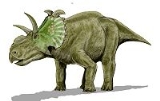
Albertaceratops
Encyclopedia
Albertaceratops was a genus
of centrosaurine
horned dinosaur
from the middle Campanian
-age Upper Cretaceous Oldman Formation
of Alberta, Canada
.
Albertaceratops is known from a single complete skull (TMP.2001.26.1
) found in August 2001 and skull and postcranial fragments. This genus is unusual in combining long brow horns
with an otherwise centrosaurine skull, as centrosaurines normally possess short brow horns. Over its nose was a bony ridge, and on its frill
were two large outwardly-projecting hooks. A phylogenetic
analysis carried out by its describer, Michael J. Ryan, found it to be the most basal centrosaurine. Additional specimens were reported from a bonebed in the Judith River Formation
of Montana
, which is equivalent to the Oldman Formation and differentiated only by the United States
/Canadian border. However, further study showed these remains to come from a chasmosaurine, Medusaceratops
. Both ceratopsids lived during the same time period, about 77.5 million years ago.
The specific name, A. nesmoi, is derived from the name of Cecil Nesmo, a rancher living in Manyberries, Alberta
, a town of less than 100 people located 71 km south of Medicine Hat. The rancher was thus honored in recognition of his efforts to aid fossil hunters.
Genus
In biology, a genus is a low-level taxonomic rank used in the biological classification of living and fossil organisms, which is an example of definition by genus and differentia...
of centrosaurine
Centrosaurinae
The Centrosaurinae is a subfamily of ceratopsid dinosaurs named by paleontologist Lawrence Lambe, in 1915, with Centrosaurus as the type genus...
horned dinosaur
Dinosaur
Dinosaurs are a diverse group of animals of the clade and superorder Dinosauria. They were the dominant terrestrial vertebrates for over 160 million years, from the late Triassic period until the end of the Cretaceous , when the Cretaceous–Paleogene extinction event led to the extinction of...
from the middle Campanian
Campanian
The Campanian is, in the ICS' geologic timescale, the fifth of six ages of the Late Cretaceous epoch . The Campanian spans the time from 83.5 ± 0.7 Ma to 70.6 ± 0.6 Ma ...
-age Upper Cretaceous Oldman Formation
Oldman Formation
The Oldman Formation is the middle member of the Judith River Group, a major geologic unit in southern Alberta. The formation is widely recognized as bearing a great number of well preserved dinosaur skeletons, as well as other fossils.-Age:...
of Alberta, Canada
Canada
Canada is a North American country consisting of ten provinces and three territories. Located in the northern part of the continent, it extends from the Atlantic Ocean in the east to the Pacific Ocean in the west, and northward into the Arctic Ocean...
.
Albertaceratops is known from a single complete skull (TMP.2001.26.1
Royal Tyrrell Museum of Palaeontology
The Royal Tyrrell Museum is a popular Canadian tourist attraction and a leading centre of palaeontological research noted for its collection of more than 130,000 fossils....
) found in August 2001 and skull and postcranial fragments. This genus is unusual in combining long brow horns
Horn (anatomy)
A horn is a pointed projection of the skin on the head of various animals, consisting of a covering of horn surrounding a core of living bone. True horns are found mainly among the ruminant artiodactyls, in the families Antilocapridae and Bovidae...
with an otherwise centrosaurine skull, as centrosaurines normally possess short brow horns. Over its nose was a bony ridge, and on its frill
Neck frill
Neck frill is the popular term for the relatively extensive margin seen on the back of the heads of reptiles with either a bony support such as those present on the skulls of dinosaurs of the suborder Marginocephalia or a cartilaginous one as in the Frill-necked Lizard...
were two large outwardly-projecting hooks. A phylogenetic
Phylogenetics
In biology, phylogenetics is the study of evolutionary relatedness among groups of organisms , which is discovered through molecular sequencing data and morphological data matrices...
analysis carried out by its describer, Michael J. Ryan, found it to be the most basal centrosaurine. Additional specimens were reported from a bonebed in the Judith River Formation
Judith River Formation
The Judith River Formation is a fossil-bearing geologic formation in Montana, and is part of the Judith River Group. It dates to the upper Cretaceous, between 80 and 75 million years ago, corresponding to the "Judithian" land vertebrate age...
of Montana
Montana
Montana is a state in the Western United States. The western third of Montana contains numerous mountain ranges. Smaller, "island ranges" are found in the central third of the state, for a total of 77 named ranges of the Rocky Mountains. This geographical fact is reflected in the state's name,...
, which is equivalent to the Oldman Formation and differentiated only by the United States
United States
The United States of America is a federal constitutional republic comprising fifty states and a federal district...
/Canadian border. However, further study showed these remains to come from a chasmosaurine, Medusaceratops
Medusaceratops
Medusaceratops is a genus of herbivorous ceratopsian dinosaur. It is a chasmosaurine ceratopsian which lived during the Late Cretaceous period in what is now Montana. It is known from two partial parietals, the holotype WDC DJR 001 and the paratype WDC DJR 002...
. Both ceratopsids lived during the same time period, about 77.5 million years ago.
The specific name, A. nesmoi, is derived from the name of Cecil Nesmo, a rancher living in Manyberries, Alberta
Manyberries, Alberta
- References :...
, a town of less than 100 people located 71 km south of Medicine Hat. The rancher was thus honored in recognition of his efforts to aid fossil hunters.
External links
- Drawing of the skull, by Julius T. Csotonyi
- An article about Cecil Nesmo from the Calgary Sun

